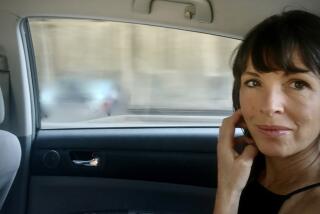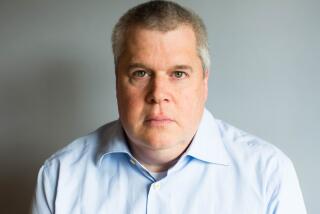Review: Karl Ove Knausgaard’s ‘My Struggle’ reckons with his boyhood

Norwegian writer Karl Ove Knausgaard’s “My Struggle” is the buzz book of the moment — or more accurately a certain kind of buzz book, for a certain kind of audience. It is also a provocation, sharing its title with one of the most notorious works of the 20th century (Adolf Hitler’s “Mein Kampf”) while seeking to break down everything we thought we knew about personal narrative.
And yet, deep in the second book of this six-volume, 3,600-page autobiographical project, Knausgaard offers us an unexpected key.
“A life is simple to understand,” he explains, “the elements that determine it are few. In mine there were two. My father and the fact that I had never belonged anywhere.” There you have it, “My Struggle” in a nutshell … although how to get at this simplicity is something else again.
Self-absorbed, expansive, constantly doubling back on itself, “My Struggle” is an attempt to make an epic of the banal facts of the author’s existence, from the distant reaches of childhood to his more recent experience as the father of three (now four) small children, for whom he bears an intense, if ambivalent, love.
“Everyday life,” he writes, “with its duties and routines, was something I endured, not a thing I enjoyed, nor something that was meaningful or that made me happy. This had nothing to do with a lack of desire to wash floors or change diapers but rather with something more fundamental: the life around me was not meaningful. … I tried to make it mine, this was my struggle, because of course I wanted it, but I failed, the longing for something else undermined all my efforts.”
As it happens, I’ve had this feeling also, not unlike (I suspect) most people who have lived with young kids. The wonder of the observation is not in what he says but in his willingness to put it on the page. At the same time, that makes it difficult to assess “My Struggle,” since Knausgaard isn’t really writing for us. Rather, he is engaged in an act of self-expiation, a public reckoning.
This is what makes Books 1 and 2 of “My Struggle” so brilliant: the understanding that in recalling or re-creating our history, we give it a meaning it would not otherwise possess. For Knausgaard, that involves a minute set of reconstructions; the last half of Book 1 describes, at length, the preparations for his father’s funeral, while Book 2 features a 60-page account of a 4-year-old’s birthday party, which becomes its own peculiarly incidental vision of hell.
What we are getting, in other words, is not an epic life but one that, like every other life, is utterly ordinary — and yet, that is where its epic stature resides.
This is prologue for Book 3 of “My Struggle,” which comes with the subtitle “Boyhood” (a nod to J.M. Coetzee, perhaps, or before him, Tolstoy) and has just been published in English. Knausgaard returns to childhood, offering what is in some ways a traditional bildungsroman about his grammar school years on the Norwegian island of Tromoya — transliterated, with unintended irony, as “Trauma” on his club soccer team’s uniform.
Knausgaard’s trauma begins at home, with his father, a teacher who doles out punishment for transgressions from losing a sock to throwing rocks at cars on a local motorway. “Inside my room,” he writes, “there was only one thing I longed for, and that was to grow up. To have total control over my own life. I hated Dad, but I was in his hands, I couldn’t escape his power. It was impossible to exact my revenge on him. Except in the much acclaimed mind and imagination, there I was able to crush him.”
None of that is new exactly; Book 1 also begins in Tromoya as a 7-year-old Knausgaard tells his father he has seen a face in the waters off northern Norway while watching a TV news report about a sunken fishing boat. For the elder Knausgaard, a devoted anti-Christian, it’s enough that the face doesn’t belong to Jesus; but to his son, the apparition is an early indication that the world is both what we make it and full of textures we will never know.
The face in the water blurs, almost imperceptibly, into a face in the window: the reflection of Knausgaard’s own face while he works. “As I sit here writing this,” he tells us, “I recognize that more than thirty years have passed. … Apart from one eye, which is glistening, and the area immediately beneath, which dimly reflects a little light, the whole of the left side is in shadow. … What has engraved itself in my face?”
The power of “My Struggle” lies in this tension, between who Knausgaard is and who he has ever been. As such, “Boyhood” is important, because it fills in key aspects of his history. It is, however, less reflective than Books 1 and 2, which makes it less effective on its own terms — a portrait of a childhood in which time is measured out in school and social life, and the drama, such as it is, revolves around music and girls.
At the same time, each volume stands always in relation to its counterparts, a point Knausgaard makes in a recent interview with Scott Esposito in Tin House. As he explains: “I didn’t plan these books; I just started to write, and then, when I had written twelve hundred pages [the first two books of ‘My Struggle’], I gave them to my editor and asked what we should do with it. … I did an extremely rough sketch — Book Three childhood, Book Four youth, Book Five the twenties, until the funeral of the father, so that those five books became a kind of circle, and then Book Six should be about the consequences of it all.”
Among those consequences is the intention to write his way out of writing: The final line of the saga (not yet translated into English) is, apparently, “And I’m so happy I’m no longer an author.” This of course is one more provocation, since if Knausgaard is not an author, then what is he? Especially in a world as mass-mediated as this, what else can art do, if indeed it can do anything, but push back against the boundaries between what is lived and what is said?
“Over recent years,” Knausgaard declares, “I had increasingly lost faith in literature. … The only genres I saw value in, which still conferred meaning, were diaries and essays, the type of literature that did not deal with narrative, that were not about anything, but just consisted of a voice, the voice of your own personality, a life, a face, a gaze you could meet. What is a work of art if not the gaze of another person? Not directed above us, nor beneath us, but at the same height as our own gaze. Art cannot be experienced collectively, nothing can, art is something you are alone with. You meet its gaze alone.”
My Struggle
Book Three: Boyhood
Karl Ove Knausgaard
Translated from the Norwegian by Don Bartlett
Archipelago: 428 pp., $27
More to Read
Sign up for our Book Club newsletter
Get the latest news, events and more from the Los Angeles Times Book Club, and help us get L.A. reading and talking.
You may occasionally receive promotional content from the Los Angeles Times.









